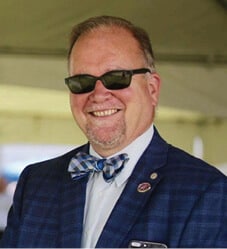A Brief History of the Miniature Schnauzer
The Miniature Schnauzer was developed from the German farm dog. These dogs were multi-purpose dogs used as herders, guard dogs, ratters, and general-purpose dogs for the working family farm in Germany. It was from these dogs that all pinscher-type breeds were developed. One of the earliest books on dogs in Germany describes the “bentchur” as this dog was called: “The dog has a… snout covered with rough-haired whiskers… His body is short, and his tail is usually docked. The topcoat is not too long but wiry…”
In 1852, C.F.H. Weiss used the term “pinscher” when translating the English word “terrier.” I think this is a good reference to the similarity of these German pinscher breeds to many of the British terriers in form, function, and temperament.
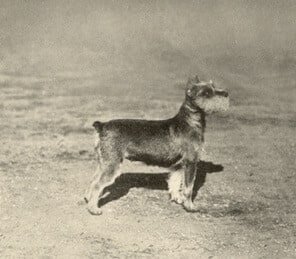
By 1876, we see evidence of these dogs developing into distinct breeds. Fitzinger, in 1876, discusses many types of pinschers that we see today; the Miniature Schnauzer or rauhen pintsch, the Affenpinscher or seiden pintsch, the German Pinscher or glatten pintsch, the Miniature Pinscher orkleinen pintsch, and the Standard Schnauzer or grossen pintsch.
By 1884, we see the first standard for the Rauhhaarige Pinscher or Rough-haired Pinscher. This standard really encompassed a variety of Schnauzers, as the size ranged from 8 to 22 pounds.
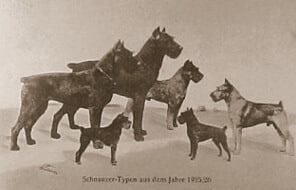
In his book, Les Races des Chien, Count Henri van Bylandt in 1894 described these farm dogs as being seen in both smooth and wire-haired coats, and ranging in size from 11-3/4” to 19-1/2” (18-36 pounds). We know that the smaller ones were typically used as rat catchers. This is also the first reference to the term Schnauzer, which he used to describe the wire-haired, bearded pinschers.
In Germany, a Pinscher Club was formed in 1895. The first studbook was subsequently published in 1902. It contained a total of 353 dogs being born as far back as 1880. There were four distinct breeds, registered as follows: 248 Standard Schnauzers, 14 Miniature Schnauzers, 8 German Pinschers, 83 Miniature Pinschers.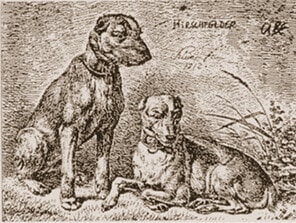
The small, wire-haired pinschers were shown in separate classes; one for Affenpinschers and one for the smaller version of the wire-haired pinscher. In 1903, the studbook first registered Affenpinschers separately from the other wire-haired pinschers. By 1910, the separation was complete; the breeds were known as Affenpinschers and Miniature Schnauzers.
The first Miniature Schnauzers were imported to the United States around 1924. Originally, in the US, Miniature and Standard Schnauzers were considered the same breed and the Wire-Haired Pinscher Club of America was formed in 1925, encompassing both breeds. In 1926, the breed was renamed to Schnauzer and began competing in the Terrier Group.
In 1933, the Schnauzer was separated into two breeds, Standard Schnauzer and Miniature Schnauzer. AKC required the parent club to split into separate clubs. At this point in the history of the Miniature Schnauzer, the American Miniature Schnauzer Club and the Standard Schnauzer Club of America came into existence. Both breeds continued to compete in the Terrier Group until 1945, whenthe Standard Schnauzer was moved to the Working Group.
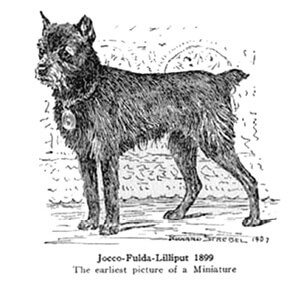
In 1945, the “Sire of our Modern Breed” emerged, Ch. Dorem Display. “Display,” while maintaining the substance and strength of the breed, possessed an elegance and refined outline that made him more competitive in the Terrier Group. He was our first all-breed Best in Show winner and our first and only Westminster Terrier Group winner—in 1947. Virtually all Miniature Schnauzers from show lines trace many (to hundreds of) lines back to Display.
Color has changed a bit over the years for Miniature Schnauzers. The first standard (Germany) in 1884 allowed a wide range of colors, which is understandable, being very early in the distinct development of the breed. As type started to become more established, we see in the 1907 German Standard more clarification and definition, “All salt-and-pepper color shades or similar bristly equal color mixtures, and solid black.” “Faults – All white, speckled, brindled, red, or bran colors.”
In the 1934 American standard, we find the emergence of our modern-allowed colors: “The color should be pepper and salt or similar equal mixtures, light or dark, and including the ‘red pepper,’ pure black, and black and tan.” The “red pepper” refers to the tan shading still allowed today. The black and tan color will gradually modify to become today’s black and silver. Any solid color other than black has always been unacceptable in our American Standard. Early breeders were diligent in standardizing the allowed colors, and today we never see any but the three allowed colors in litters from show lines.
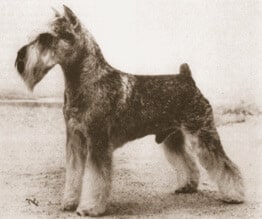
Over the past couple of decades, we have been fighting a battle (as have some other breeds) to stop colors—from questionable breeding—from creeping into our breed (i.e., white, liver, chocolate, parti, etc.). We are in the midst of changing our standard to make any color other than our three allowed colors (salt & pepper, black & silver, and black) a disqualification.
From their initial development, Miniature Schnauzers have always been cropped and docked. This was done to protect the dogs while performing their functions of ratting and such. Our grooming is also reminiscent of our Schnauzers’ function. The beard/eyebrows and longer leg hair also protected the dog from the rat’s bite. We believe cropping and docking, as well as our grooming, are essential parts of the history, heritage, and essence of the Miniature Schnauzer and must be preserved.
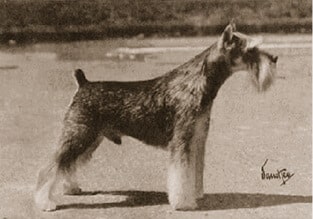
The Miniature Schnauzer in the US is shown in the Terrier Group—and always has been. I believe the Miniature Schnauzer, while not strictly a Terrier by definition since they are not of British descent, is truly a Terrier. They are the German version of a Terrier. From earlier in this article you have seen that our Schnauzers have the same functions of many of the British Terrier breeds (i.e., Wheatens, Kerries, etc.). They were working farm dogs and ratters. They are constructed similarly to many Terrier breeds and have the typical wire coat.
Sometimes the designation of not being a “real” Terrier hurts us in Group competition, although there are some judges who recognize us as the Terrier that we are. As a matter of fact, we have actually gone Best in Show three times at the world’s preeminent Terrier Show, Montgomery County Kennel Club: In 1955 with Dody’s Demtri, and in 1968 and 1969 with Ch. Mankit’s to the Moon. Our top Bestin Show winner in the breed is Ch. Regency’s Twist of Fate with 11 all-breed Bests in Show.
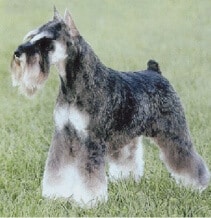
Our dogs still demonstrate their “terrier” attributes today by participating in Earthdog tests and by taking care of all sorts of varmints around our homes. In addition, they also serve as excellent guard dogs. (No one gets past our doors without the diligent alarms from our Schnauzers, of course!)
While not an ancient breed by any means, our origins do go back almost 200 years. Miniature Schnauzers continue to be a popular breed in the US and around the world. This is due in no small part to their playful, loyal, and friendly temperament. They are ideal housedogs and there is none better as a companion.
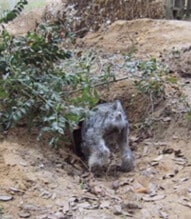
Are you looking for a Miniature Schnauzer puppy?
The best way to ensure a long and happy relationship with a purebred dog is to purchase one from a responsible breeder. Not sure where to begin finding a breeder?
Contact the National Parent Club’s Breeder Referral person, which you can find on the AKC Breeder Referral Contacts page.
Want to help rescue and re-home a Miniature Schnauzer dog?
Did you know nearly every recognized AKC purebred has a dedicated rescue group? Find your new best friend on the AKC Rescue Network Listing.
Miniature Schnauzer Breed Magazine
Showsight Magazine is the only publication to offer dedicated Digital Breed Magazines for ALL recognized AKC Breeds.
Read and learn more about the friendly Miniature Schnauzer dog breed with articles and information in our Miniature Schnauzer Breed Magazine.
Error embedding FlippingBook shortcode, please check the flipbook url. (https://digital.showsightmagazine.com/view/840860/)











